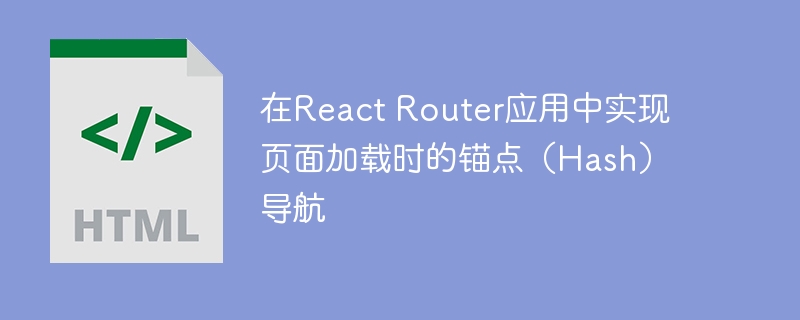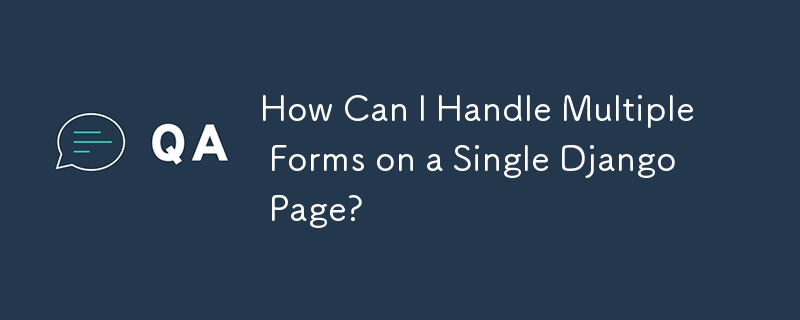Found a total of 10000 related content

How to Use the HTML5 History API for Single-Page Applications?
Article Introduction:This article explains the HTML5 History API for building Single-Page Applications (SPAs). It details pushState() and replaceState() for manipulating browser history without page reloads, emphasizing clean URLs and improved user experience. The arti
2025-03-10
comment 0
1075

How to write a basic HTML5 page template?
Article Introduction:Declare the document as HTML5 to avoid the browser from entering weird mode; 2. Define the root element and specify the language to improve accessibility and SEO; 3. It includes ensuring correct character encoding, implementing responsive design, and setting page title; 4. Place all visible content, optionally add CSS, favicon and JavaScript links; this template is complete and compatible with modern browsers, and is suitable for any new HTML file.
2025-07-26
comment 0
1040

How to build a single page application (SPA) with HTML5?
Article Introduction:Using HTML5 to do single-page application (SPA) requires combining JS and CSS. The core lies in front-end routing, dynamic content loading and good structural organization. 1. Use HistoryAPI to implement front-end routing, control URL changes through pushState/replaceState and listen to popstate event processing navigation; 2. Load content dynamically, obtain data or templates asynchronously according to the current path and render to the main container, so as to achieve page switching without refresh; 3. Imitate the component structure, treat each page as an independent component, control loading and unloading through JS, and reuse common parts such as the head and bottom; 4. Load resources asynchronously, introduce JS/CSS as needed, and use lazy loading and preloading strategies to improve performance. Master these four points
2025-07-10
comment 0
263


How to create custom single post templates
Article Introduction:The key to creating a custom single post template in WordPress is understanding the template hierarchy and correctly naming the files. 1. First understand the template loading priority of WordPress. It will look for single-{post_type}.php, single-{category}.php, single.php and index.php in turn; 2. Create corresponding template files based on article classification or custom article types, such as single-news.php or single-portfolio.php, and ensure that the classification slug is correct; 3. For specific articles, you can use the page template method, and declare the template name by adding comments and using plug-in to achieve selection.
2025-08-25
comment 0
324

HTML5 history API for single page applications
Article Introduction:HTML5HistoryAPI is an interface for operating browser history. It implements SPA refresh-free routing through pushState, replaceState and popstate. Its core functions include: 1.history.pushState() adds a new history, suitable for page switching; 2.history.replaceState() replaces the current record, suitable for updating the URL without adding new history; 3.window.onpopstate listens to the browser's forward and back events. Front-end routing realizes navigation by intercepting link clicks, calling pushState to update the URL, loading content based on the path and listening to popstate
2025-07-06
comment 0
500

Can a single HTML5 page have multiple tags?
Article Introduction:Yes, an HTML5 page can have multiple tags. 1. Multiple tags can be used to display video collections, teaching clips, social media videos or compare content shot from different angles; 2. When using it, you need to pay attention to the browser's restrictions on automatic playback. It is recommended to set muted attributes or control playback through JavaScript; 3. You need to pay attention to performance issues to avoid page lag, which can be solved by delaying loading and optimizing video encoding; 4. It is recommended to unify the control style and design reasonable interactive logic, such as pausing other videos to improve the user experience.
2025-06-28
comment 0
516

How to Use the Mouse Wheel Event in HTML5 Pages
Article Introduction:This article explores how to enhance HTML5 web pages with mouse wheel interactivity, going beyond standard page scrolling to enable actions like zooming. The core challenge lies in cross-browser compatibility, particularly with Firefox's use of the
2025-02-28
comment 0
1078

How to use template hierarchy
Article Introduction:Making good use of WordPress template levels can improve theme development flexibility. The core is the "priority matching" mechanism, the more specific the template, the higher the priority. For example, when accessing the article page, WordPress will look for single-{post_type}.php→single.php→index.php; classification archive pages will be matched in the order of archive-{post_type}.php→archive.php→index.php; other such as home page, search page, and 404 pages also have corresponding matching rules. To determine which template to build on the current page, it can be identified through the URL type, or used to assist with the plug-in (such as "WhatTheFile").
2025-08-21
comment 0
911

How to Customize WooCommerce Product Pages
Article Introduction:Key Points
WooCommerce product page customization uses operations and filter hooks to directly modify the theme file without modifying the tags of the template file.
Customize the product page by loading the single-product.php file and copying the template in the theme, all changes are made in a copy, ensuring that custom changes are not affected when updating the theme and plug-in.
You can create a custom product page or product category by adjusting the custom templates for these pages and ensuring that the new product or category you are added is at the end of the content-single-product.php file.
Use plugins such as Elementor and Beaver Builder, no
2025-02-10
comment 0
948

Implement Hash navigation when page loading in React Router application
Article Introduction:This article explains in detail how to effectively implement the need to locate and scroll to a specific page area through URL hash (#) when page loading in a single page application built by React Router. In response to the problem that React Router default behavior may prevent traditional browser anchor navigation, the tutorial provides a solution that utilizes the React lifecycle or useEffect hook, combined with window.location.hash or useLocation and element.scrollIntoView() method for programmatic scrolling, ensuring that users can jump to specified content smoothly and improve user experience.
2025-08-18
comment 0
613

How to create a full-page scroll website with HTML5
Article Introduction:The key to creating a full-screen scrolling website is to use HTML5 and CSS to set each page area to the viewport height. The answer is to achieve full-screen effect by setting the height of each section element to 100vh and combining the flexbox layout. Then enable scroll-behavior:smooth in CSS to achieve smooth scrolling. At the same time, you can optionally add a fixed navigation bar to improve the user experience. Interactive functions such as navigation highlighting can be achieved through JavaScript, and finally build a lightweight, responsive and multi-device-compatible full-screen scrolling website, which fully realizes the common visual narrative effects in modern web design.
2025-08-25
comment 0
943

Implementation strategy of anchor navigation when page loading in React Router application
Article Introduction:In React single page application, when used in combination with React Router, traditional browser URL hash (#id) navigation cannot directly realize the automatic scrolling to a specific anchor when the page is loaded. This article will introduce in detail how to combine the scrollIntoView method of JavaScript through React lifecycle hooks (such as useEffect) with JavaScript's scrollIntoView method to automatically locate and scroll to the URL to specify the corresponding DOM element of the hash in the URL, thereby optimizing the user experience.
2025-08-18
comment 0
320

Creating Reusable Content Structures with HTML5 Template Tag
Article Introduction:HTML5 tags are used to create reusable lazy content structures. The specific steps are: 1. Define the template; 2. Obtain and clone the template content through JavaScript; 3. Insert the clone content into the page. Its features include default invisible, support for any HTML, and require JS operations. It is suitable for scenarios such as component structure, dynamic loading, and preloading resources. The scripts and styles in the template need to be specially processed and cannot be nested in specific tags.
2025-07-06
comment 0
959

Automatically stop playing when navigating the audio player page in React application
Article Introduction:This article aims to solve the problem of continuous playback of audio players after page jumps in React single page applications. The core solution is to use the cleaning mechanism of React useEffect Hook, call the stop method provided by the audio library (such as useSound) when component uninstallation, or directly operate native HTML5 Audio elements for pause and reset to ensure timely release of resources and optimize user experience.
2025-08-08
comment 0
667

How to use virtual scrolling for large lists in Vue
Article Introduction:Virtual scrolling improves performance of large lists in Vue by rendering only items visible within the viewport. 1. Use vue-virtual-scroller: Install and introduce libraries, register DynamicScroller and DynamicScrollerItem components globally or locally; 2. Use DynamicScroller to wrap the list in the template, set properties such as:items, min-item-size and page-mode; 3. Each content is rendered by DynamicScrollerItem, and the size changes are handled through size-dependencies; 4. Alternative vue-virtual-scr
2025-09-08
comment 0
975

How do I choose the right Yii application template for my project?
Article Introduction:Choosing the appropriate Yii application template depends on the project size, structural needs and long-term goals. 1. The basic template is suitable for small projects, such as APIs or single-page applications; the advanced template supports multiple entry points and user roles, and is suitable for large and scalable applications. 2. Choose basic templates for simple projects, and choose advanced templates for complex systems. 3. Check whether the template contains pre-built functions, such as RBAC, AdminLTE theme or API structure, to save development time. 4. Considering the team size and future scalability, small teams can start from the foundation, and plan to grow directly using advanced templates. In short, start small, unless you are sure that more structure is needed, the template is just the starting point and can be reconstructed later.
2025-07-29
comment 0
838

How to make a parallax scrolling effect with HTML5?
Article Introduction:To realize the parallax scrolling effect in HTML5, you need to combine HTML, CSS and JavaScript. The core is to allow different page elements to scroll at different speeds. 1. The HTML structure should contain multiple independent layers, such as using different class names to represent background, intermediate content and foreground. 2. CSS uses position:absolute and translateZ to create a 3D depth sense. The smaller the value of the background layer, the slower the scrolling. 3. JavaScript can listen to scroll events, dynamically adjust the translateY value, and control the scroll speed of each layer by multiplying by a coefficient. 4. Pay attention to performance optimization and use requestAnimationFrame
2025-07-15
comment 0
759

Working with Reusable Content Fragments Using the HTML template Tag
Article Introduction:Tags are a tag introduced by HTML5 to define reusable content fragments. They are not rendered immediately, but can be dynamically inserted through JavaScript. The usage process includes: 1. Defining the template; 2. Cloning the content; 3. Inserting the DOM. For example, get the template through document.getElementById, call cloneNode(true) and insert the page. When dynamically filling the data, content binding can be achieved by operating the cloned DOM elements, which is suitable for building product lists, user cards and other components. When using it, be careful not to directly access template sub-elements, avoid ID conflicts, handle style scopes, and can also create encapsulation components with WebComponents.
2025-07-11
comment 0
1026



















